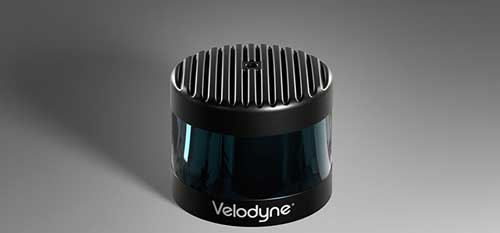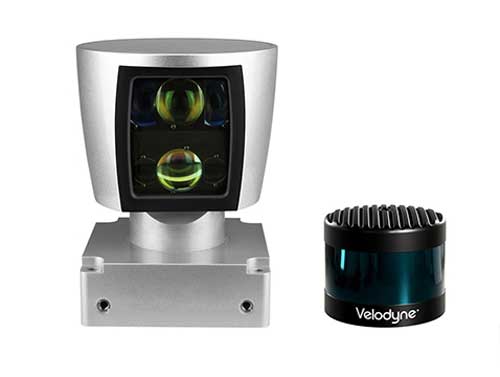On November 8th, laser radar head card maker Velodyne announced the official launch of the 128-line laser radar VLS-128, which has twice the detection range compared to Velodyne's 64-line laser radar, and the resolution (point cloud density) is quadrupled. According to the calculation of the 2.2 million per second point cloud of the 64-line laser radar, the number of points per line of 128 lines will reach 8.8 million. At the same time as the performance upgrade, its volume is reduced by 70% compared with the 64-line "big flower pot".
This article refers to the address: http://

The detection distance of the VLS-128 has been upgraded to 200 meters and still works in a rotating scan to obtain a 360° horizontal annular field of view. The vertical viewing angle is 40°, and the middle dense two-headed arrangement is adopted to obtain a higher vertical angular resolution in the critical detection area—0.17° (0.31° if evenly arranged) . In other words, the pixel (point cloud) is denser. The advantage of this is that with the associated algorithms, small obstacles or pedestrians can be identified at greater distances.
Long-distance recognition is critical for autonomous driving – without it, the unmanned vehicle can only operate at low speeds. If a pedestrian can be identified at a distance of 200 meters, then at 100 kilometers per hour, the unmanned vehicle also has more than 6 seconds to complete the driving decision to the car brake. Such high-beam LIDARs will significantly improve the safety of unmanned vehicles at high speeds – currently, in the case of unenclosed roads, the speed of unmanned vehicles of individual autonomous driving companies does not exceed 50 miles.
However, the substantial increase in the laser radar harness in the traditional way will result in a multiplication of the volume of the product, and will also greatly increase the difficulty of mass production. But from the VLS-128's 70% smaller size, while preparing to produce samples next year, Velodyne has come up with solutions for both problems.

The volume reduction is related to Velodyne's efforts in the laser chip component chip. In December last year, Velodyne released the ASIC chip of the laser radar transmitter, which integrated a large number of scattered components into a dedicated chip, which greatly saved space. In addition, Velodyne also proposed to get the chip on the receiving end this year, and the official launch of VLS-128 may also benefit from the progress in this direction.
The ASIC of the internal components of the lidar also helps in mass production. Multi-device integration into a single chip can be applied to a large-scale production using a mature semiconductor process, reducing the need to integrate it into the middle of a board. In addition, Velodyne has developed a complete set of automated calibration production tools for mass production.
Previously, the Velodyne 128-line laser radar quietly showed samples to customers at the Frankfurt Motor Show, and the current version is more mature. At the CES next year, VLS-128 will be officially unveiled, and there will be more specific parameters to be publicized. From the current information, Velodyne has set a new benchmark for the laser radar industry.
However, the benchmark is a benchmark, and it has been around for a while. In Velodyne's plan, the 128-line laser radar at the car level will not be available until 2021. Therefore, the 64-line large disk will remain the most prominent sign of autonomous driving in the next few years.
In addition, for many OEMs, the immediate need is still a moderately affordable, low-cost laser radar to help achieve the automatic driving function of L3 and below. Therefore, the most intense war is still how to reduce the cost of low-beam (less than 64 lines) laser radar.
Canaan is a leading provider of supercomputing solutions, distinguished for superior cost-efficiencies and performance. In addressing the limitations of today`s computing hardware, Canaan strives to advance the world we live in by powering transformative technologies.
Canaan is renowned for having invented the world`s first ASIC-powered Bitcoin Mining Machine in 2013, radically catalysing the growth of a computationally-advanced bitcoin mining sector.
Developed through academic research, rigorous expertise in semiconductor design, and backed by a robust network of strategic partners, Canaan continues to expand its suite of advanced hardware offerings, exploring opportunities across some of the world`s most exciting emerging technologies.
Canaan AvalonMiner:Canaan AvalonMiner 821,Canaan AvalonMiner 841,Canaan AvalonMiner 741,Canaan AvalonMiner 1246,Canaan AvalonMiner 921,Canaan AvalonMiner 1166 Pro
Canaan Avalonminer,1166 Pro 66T,Avalon 821,Avalon 1246,avalon miner
Shenzhen YLHM Technology Co., Ltd. , https://www.ylhm-tech.com